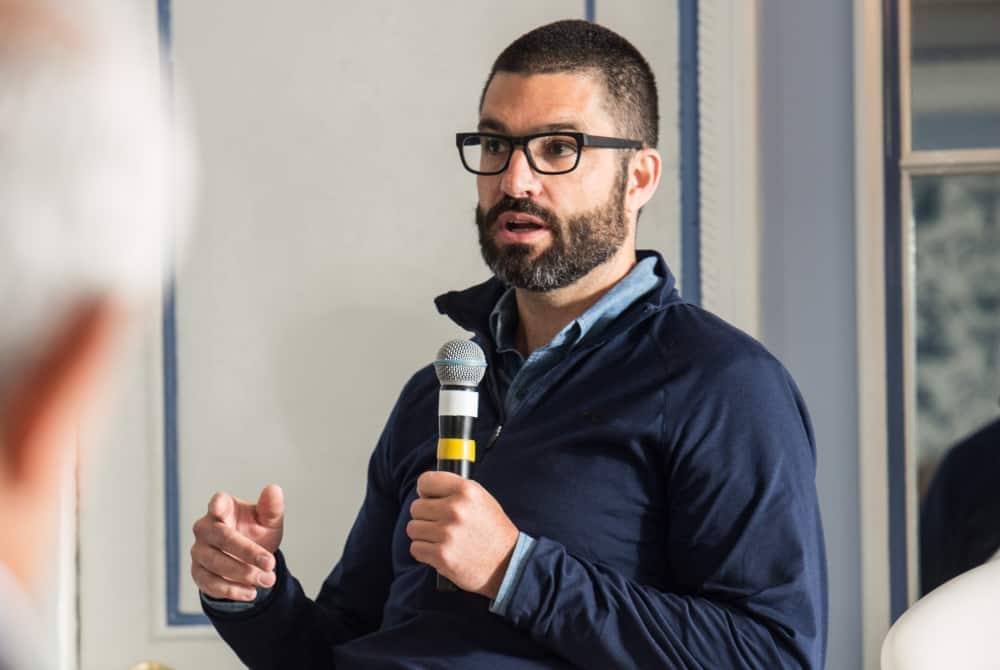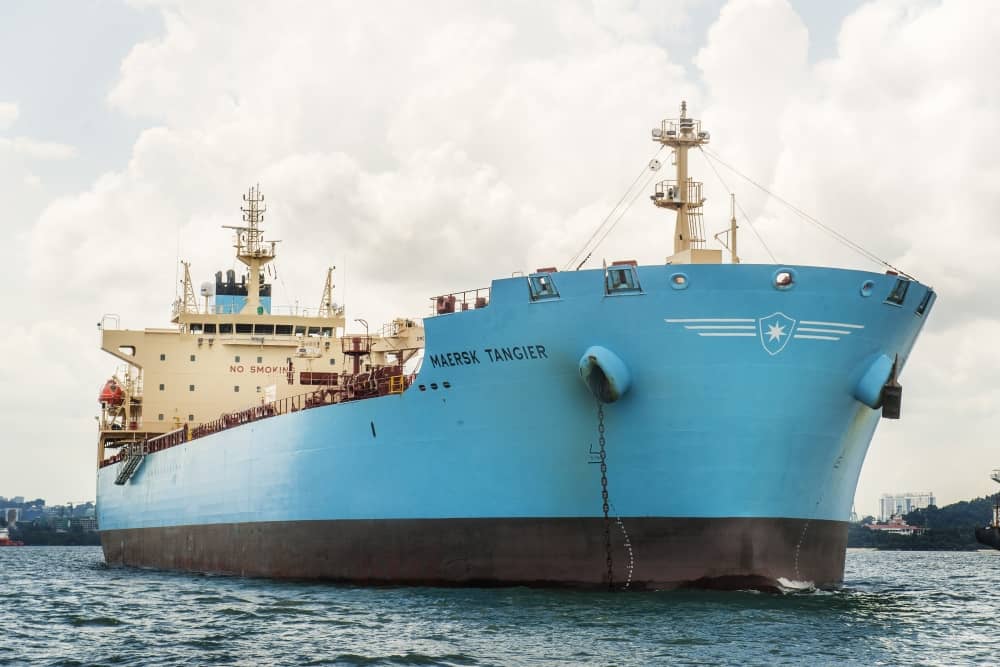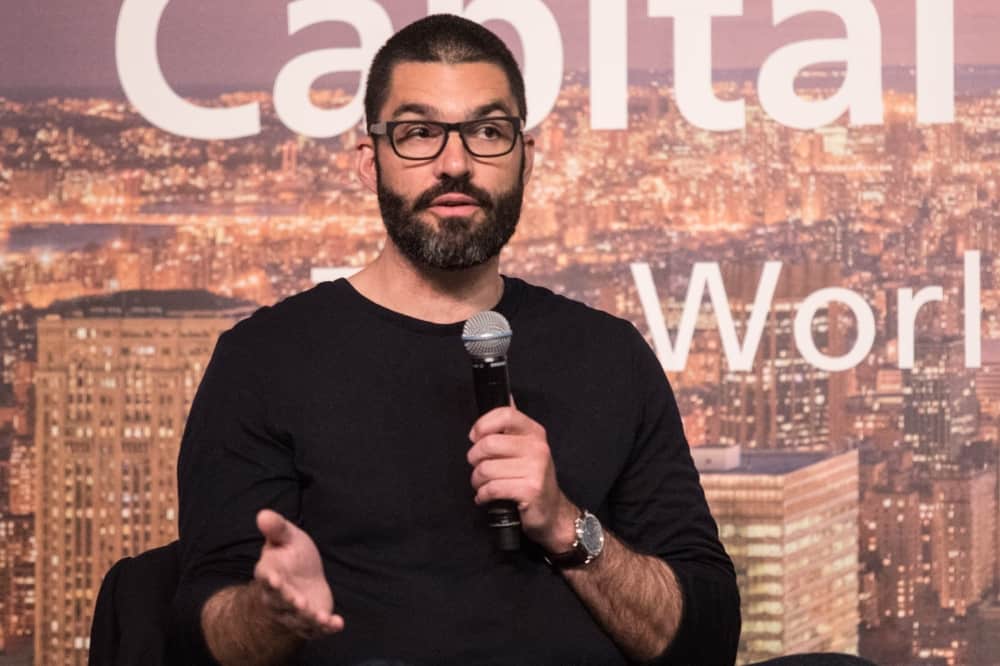This is a milestone year for CargoMetrics, the Boston-based technology company whose big-data machine tracks and analyzes global seaborne trade in near-real time.
It now receives and processes over a billion pieces of unique information every single day and has a full decade of historical ship-movement data under its belt. It’s about to enter the next stage of its fleet-optimization partnership with Maersk Tankers and has just added two more partners on the dry bulk side – Fednav and Western Bulk. It’s also planning to launch a revolutionary cargo-pricing transparency product called TruFreight.
“The billion pieces of unique information a day – that’s a huge milestone for us,” CargoMetrics co-founder and chief executive officer (CEO) Scott Borgerson said in an exclusive interview with FreightWaves.
“Back in the beginning, we struggled to receive and process tens of millions of pieces of data a day. There’s absolutely no way we could have done then what we’re doing now. First, because all of that data wasn’t previously being produced and captured, and second, because the type of big data infrastructure, cloud computing and automation required to process and make sense of that volume of data has only become possible in the last decade.”
Borgerson also highlighted the milestone of being able to draw on 10 years’ worth of data compiled since the company’s 2009 soft launch – a head start competitors will be hard-pressed to overcome. “That is really important for building models and looking for correlations and forecasting patterns and being quantitatively predictive,” he stressed.
“Over the decade, we’ve had multiple generations of algorithms and the system has gotten smarter and smarter and the fidelity of the cargo data has gotten better and better. The statistical confidence and probabilities of being right keep going up and up.
“Amazon used to offer you not quite the right thing. Today, it knows exactly what day of the week you need toilet paper. It’s freaky. It’s the same way with shipping. We needed to get to that critical mass of data, and for the cargo types we’ve ‘solved,’ we’re really good at it. We’re unique in that we’re statistically calculating what the cargo is – the data tells us the answer. We benchmark that against customs, manifest and government data after the fact and there’s a very powerful correlation.”
Some very big names have backed the company. One of CargoMetrics’ investors is Eric Schmidt, former CEO and executive chairman of Google. Other marquee investors include Howard Morgan, co-founder of quant investing giant Renaissance Technologies; famed hedge fund manager Paul Tudor Jones; Israeli shipping magnate Idan Ofer; shipping services leader Clarksons PLC; and Maersk Tankers.
Impressive as all that sounds, it could be just the beginning.
“I think we’ll get to 10 billion pieces of unique information a day in a few years,” he predicted. “We’re very early in the journey. If this was a baseball game, I think that maybe we’re just now entering the second inning.”
What’s the game plan for the bottom of the second, and the third inning and beyond? Borgerson provided perspective on the company’s plans for the three basic pillars of its business – the hedge fund, the fleet-optimization platform and the freight price reporting agency – and on how it plans to handle its growing portfolio of patents.
Pillar 1: Quant hedge fund
In its early years, the company was focused on using vessel-tracking data to place bets in financial markets via its ‘quant’ hedge fund. Its systems analyzed cargo flows and used a diversified, quantitative, algorithmic approach to statistically forecast prices and guide investment decisions.
“That part of our business is certainly where we started and we’re still excited about it,” said Borgerson, who acknowledged that he’s less comfortable speaking about this pillar than the other two.

Scott Borgerson at the recent Marine Money tech accelerator forum. Photo courtesy of John Galayda/Marine Money
“I will say that we have better fundamental data about the huge volume of global trade that ships carry, and this gives us forecasting power on a number of different commodities and macro markets and allows us to build a systematic investing approach.”
He also emphasized that the experience with the hedge fund has informed the other two parts of the business, both of which are now major focuses for growth. “It has been very helpful in allowing us to better understand and think about the other two pillars,” he said.
Pillar 2: Fleet optimization
The second pillar of the business model centers on fleet-optimization partnerships with shipping companies. This phase kicked off in July 2017 with its partnership with Maersk Tankers, a company that currently operates 165 product tankers.
The concept is to work with a shipping partner, allow that partner to use CargoMetrics’ algorithms to optimize fleet moves to earn more and to simultaneously learn from CargoMetrics’ team of scientists, and in return, allow CargoMetrics to use the experience with the shipping partner to improve its own algorithms, and pocket a piece of the partners’ upside.
Such deals are win-win because CargoMetrics has zero interest in owning ships and ship owners have no interest in spending a decade of time and huge sums of money building up their own global shipping data analysis machines.

CargoMetrics’ goal is to allow its partners to obtain repeatable ‘alpha’ (return above market performance). “This is not about machine replacing man, it’s about man and machine. It’s about professionals making more optimized commercial decisions aided by a better data system,” said Borgerson.
One of the systems developed with Maersk Tankers is called SimTanker. “SimTanker is basically a performance measurement and back-testing tool. If they [partners] have a question like: ‘What if I redistribute my fleet geographically more toward a Pacific bias?’ or ‘What if I took this cargo and this ship to Australia?’, it allows them to measure the results. It’s like with sports teams. They ask: ‘How will this combination of players or this strategy work?’ And they run thousands of simulation games.”
The partnership with Maersk Tankers is about to enter the phase where CargoMetrics delivers the alpha. Borgerson revealed that the system will be rolled out with Maersk’s larger LR2 tankers (which have capacity of 119,000 to 123,000 deadweight tons or DWT) this summer, with the intention to incorporate the smaller MR tankers (52,000-54,000 DWT) and other ships this fall or shortly thereafter.
Dry bulk is the next frontier. On June 17, the company signed a fleet-optimization partnership deal with Canada’s Fednav, which operates a fleet of over 100 bulkers, including 63 owned vessels. On June 27, it inked a similar agreement with Norway-headquartered Western Bulk, which charters-in over 150 bulkers.
“In some respects, bulkers are a harder problem to solve than product tankers, depending on the bulker type,” said Borgerson.
“The smaller bulkers carry a really broad diversity of cargoes. There’s even more optionality in the decision tree for bulkers [than product tankers], in terms of geographies to sail to, cargoes to pick up, and seasonality components.
“We talk about it in terms of a chess board and learning the statistics of how the game works. The dry bulk game has more squares than the tanker game, so it’s harder to solve, but that means it should also have a higher alpha potential, because more squares means more complexity, which means there’s a greater opportunity for our machine to optimize the system.”

Over its history, CargoMetrics has progressed from sector to sector along a trajectory of increasing complexity. It began a decade ago with liquefied natural gas shipping, the easiest system to model, then crude tankers eight years ago.
FreightWaves asked Borgerson whether container ships were on the list after product tankers and dry bulk. He answered, “We view containers as fundamentally apples and oranges with bulk.
“We measure the container fleet in terms of fuel consumption, speed and total volume of cargo as a proxy for trade, but we’re not trying to figure out what’s in the containers or optimize the supply chain for containers. We’re going to let Flexport and Freightos do the boxes. We’ve got our hands full in the bulk domain.”
Pillar 3: Freight price reporting agency
The first pillar of the company’s strategy is about trading on its own account, the second about partnerships with industry players, the third about creating a product to be sold to others.
This facet of the business stems from a curious fact about global shipping freight rates – almost no one really knows what the true price of shipping bulk commodities on most routes actually is.
Read a broker’s report or a financial analyst’s report or trade journalist coverage of those reports and you’ll find lines like, “Medium-range product tankers averaged $17,000 per day, up 23 percent week-on-week.” But on which route? Does this refer to some sort of benchmark route, or a weighted mix of routes meant to approximate the global average? If it’s a weighted average, how approximate is it? What’s the price on a route not covered by the indices?
For public shipping companies, this issue pops up frequently, when actual charter earnings for a quarter turn out to be much different than what had been implied by published indices.
Scorpio Tankers president Robert Bugbee once said on a conference call with analysts, “We don’t pay our chartering departments bonuses based off the spread over the indices because the indices don’t fairly reflect what is actually going on – at all.”
According to Borgerson, “One of the biggest surprises is we found that ships are not going on benchmark routes. Business is being priced against a Baltic [Exchange] route that the ships have never sailed.” He believes traditional pricing mechanisms “do not reflect the reality that we can see in our systems and can measure.”
The new TruFreight offering will be designed as a freight price reporting agency and will be introduced for the tanker sector initially. It will strive to provide transparency on specific routes, costs, risks and what CargoMetrics calculates is the actual price, under the monikers TruRoute, TruCost, TruRisk, and the number everyone is looking for – TruPrice.
“Right now, there’s not a lot of data-driven transparency on real-time cost and pricing on the routes vessels are actually going on, to put it mildly. What we’re trying to do with TruFreight is completely rethink the way freight pricing works, and we couldn’t have done it without the first two pillars.
“If we provide real-time transparency into ship movements and help make the market more transparent in a real-time way, that could be a step change for freight markets. The more transparency there is, the better the derivatives products are, which will let you manage risks better and maybe dampen some of that price volatility,” he said, adding, “We’ll have more to say about TruFreight as the year goes on.”
Patents
CargoMetrics currently has four patents posted on its website. “We have more in the works and the ones that we have are quite broad,” said Borgerson.
The 2016 U.S. patent is for an “invention” that “provides a global strategic picture of commodity movements generated by tracking ships from satellite and other sources and then combining ship location and movement information with at least one other data set, such as vessel, port, cargo, weather are market data,” along with a time history of those data sets.
Its 2018 U.S. patent protects the combination of one or more of Automated Identification System (AIS), image, and radar data; using data to infer whether ships are full or empty to create a view on cargo supply and available ship supply; using other data to imply how much cargo is available at various ports and what ships are within range; and using all of this to generate vessel routing suggestions.
There are a significant number of established companies, as well as tech startups, using AIS data in a way that appears to infringe upon CargoMetrics’ patents. Concern has been expressed to FreightWaves by more than one source about the implications of CargoMetrics enforcing its patents.
When asked about this possibility, Borgerson replied, “We are interested in licensing our patents strategically and thoughtfully and we’re actively considering what the right move is with our growing portfolio of intellectual capital. We have already licensed our patents [to one company] a few months ago and we are currently engaged in several active conversations to license our patents to others.”
He continued, “We don’t want to quash innovation in this space. We want to encourage innovation. We love this industry. On the other hand, we are a private for-profit technology company in America. We are actively contemplating a strategy [on enforcement] and we are going to be thoughtful in the way we begin enforcing our patent portfolio.”
The CargoMetrics team
With all of its expansion plans, CargoMetrics would seem to be a company that’s heavily staffing up. Borgerson declined to disclose the company’s current headcount and disputed this logic.
“The thing about that question is that people assume headcount is tied to business success and that’s actually not true. What we’re best at is big-data computations and automation, so the trick is to get servers on the cloud to do the work, not people.
“There are companies out there trying to augment some of their AIS algorithmic work – which by the way, is probably in violation of our patent – with people doing FOIA [Freedom of Information Act] requests or literally getting on the telephone or trying to manually answer questions.
“We don’t think that scales. We think there’s a limit to how big that kind of business can be, because you can’t automate that work. I would take one PhD mathematician or physicist or big-data software engineer over 100 analysts who are trying to read customs or brokerage information or gather data.
“The reason Google gives you an excellent search result so quickly is that it has automated the machine. That’s what we’re doing at CargoMetrics. Headcount is not the right measure. The right measure is the volume of data consumed and the efficiency with which it’s processed and the way we’ve optimized the algorithms and quantitative systems. That’s what we do so well.”
He is effusive in his praise of the employees who comprise his undisclosed headcount. He credits them for how far CargoMetrics has come and for creating the algorithms that drive the automation machine.
“These are some of the brightest data scientists and software engineers in the world. I could not be more humbled and excited and proud to have worked with such a brilliant group of people. They’re awesome. They get all the credit. I’m just the CEO.
“What really motivates our team is the challenge of solving very difficult technical problems and puzzles,” he said. “And shipping has some really cool puzzles to solve. It could actually be one of the biggest puzzles out there right now.” More FreightWaves/American Shipper articles by Greg Miller











